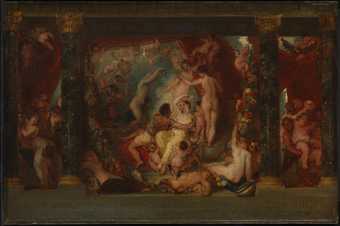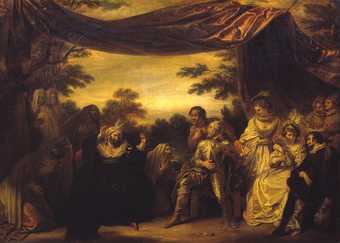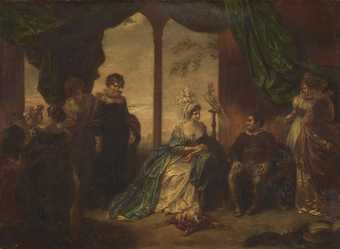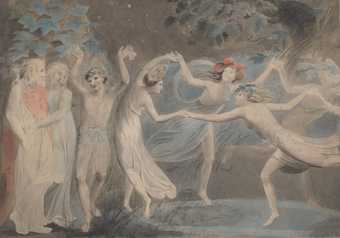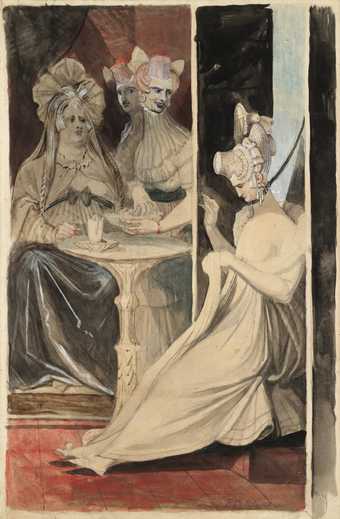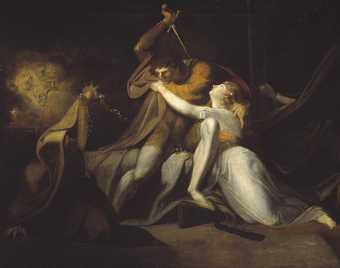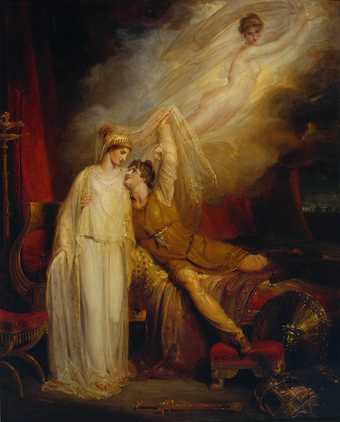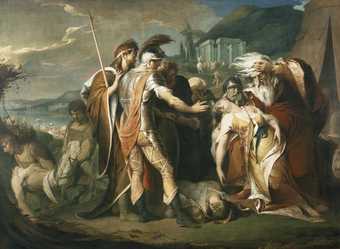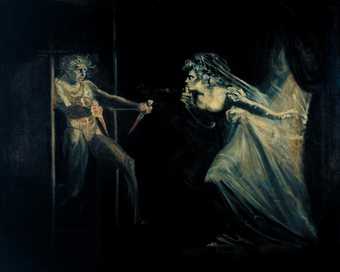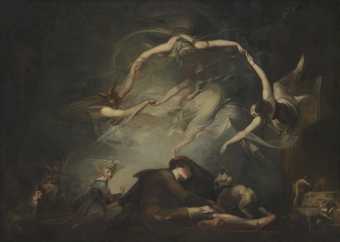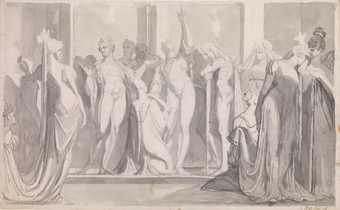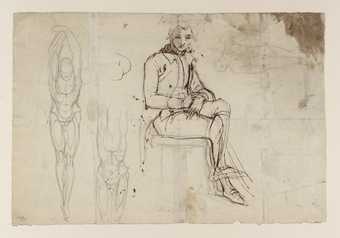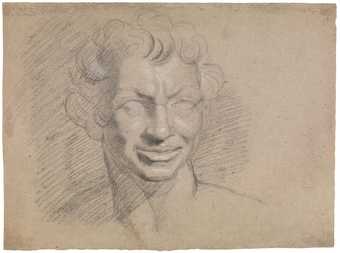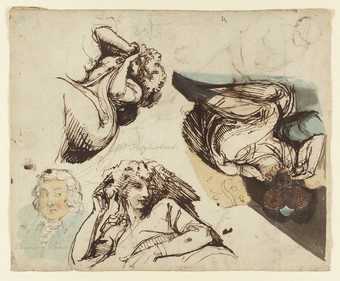In Tate Britain
- Artist
- Henry Fuseli 1741–1825
- Medium
- Oil paint on canvas
- Dimensions
- Support: 2172 × 2756 mm
frame: 3167 × 2600 × 155 mm - Collection
- Tate
- Acquisition
- Presented by Miss Julia Carrick Moore in accordance with the wishes of her sister 1887
- Reference
- N01228
Summary
Fuseli was introduced to Shakespeare's plays during his student days in Zürich with the Swiss scholar Jacob Bodmer. A Midsummer Night's Dream held a special appeal for him, in that it explores the realms of the supernatural.
In the picture Fuseli illustrates a moment from Act IV scene 1, in which Oberon, in order to punish her for her pride, casts a spell on Queen Titania, as a result of which she falls in love with Bottom, whose head has been transformed into that of an ass. In the play she murmurs lovingly to the object of her affections,
Come, sit thee down upon this flowery bed,
While I thy amiable cheeks do coy,
And stick musk roses in thy sleek smooth head,
And kiss thy fair large ears, my gentle joy.
Fuseli's imagination is given free reign in this fantastical scene. Titania calls on her fairies, who are wearing contemporary dress, to attend to Bottom: Pease-blossom scratches his ass's head; Mustard-seed perches on his hand in order to assist; and Cobweb kills a bee and brings him the honey-bag. A leering young woman offers him a basket of dried peas. The young woman leading a dwarf-like creature by a string symbolises the triumph of youth over old age, of the senses over the mind and of woman over man. The hooded old woman on the right is holding a changeling newly formed out of wax. Similarly, on the left of the picture, the group of children are artificial beings created by witches.
The picture draws on several artistic sources. Fuseli has adapted Titania's seductive pose from Leonardo da Vinci's Leda
(c.1506, Galleria Borghese, Rome). The elves plunging into the calyx on the right are inspired by Botticelli's illustration of Canto XXX of Dante's Paradiso (c.1469). And the small girl with a butterfly head on the left derives from a type of child portrait
developed by Reynolds, whereby the child's features closely resemble a cat, mouse or other small creature posed with her.
Fuseli painted several other scenes from A Midsummer Night's Dream, including Titania's Awakening (1785-90, Kunstmuseum, Winterthur), where the Queen awakes and recounts her 'dream' to Oberon. He was also inspired by other Shakespearean texts and was particularly drawn to the supernatural and irrational elements in such plays as The Tempest, Hamlet and King Lear.
Further reading:
Henry Fuseli 1741-1825, Tate Gallery, London 1975, pp.61-2, reproduced p.62.
Jeremy Maas, Victorian Fairy Painting, exhibition catalogue, Royal Academy of Arts, London 1997, p.12.
Frances Fowle
December 2000
Does this text contain inaccurate information or language that you feel we should improve or change? We would like to hear from you.
Display caption
This grand painting shows a scene from Shakespeare’s A Midsummer Night’s Dream 1595-6. King and queen of the fairies, Oberon and Titania, argue over who has care of a human child. To distract Titania, the fairy Puck casts a spell. This makes Titania fall in love with a human called Bottom, whose head has been changed to a donkey. One fairy, Moth, holds his finger to his lips as attendants take the child away. Henry Fuseli’s picture was one of the stars of the famous Shakespeare Gallery in London, opened by publisher John Boydell in 1789.
Gallery label, October 2020
Does this text contain inaccurate information or language that you feel we should improve or change? We would like to hear from you.
Features
Explore
- emotions, concepts and ideas(16,416)
-
- emotions and human qualities(5,345)
-
- love(516)
- universal concepts(6,387)
-
- transformation(186)
- characters(438)
- actions: expressive(2,622)
-
- embracing(429)
- arm / arms raised(839)
- flying(173)
- sitting(3,347)
- standing(3,106)
- female(1,681)
- magic and occultism(206)
You might like
-
Thomas Stothard Intemperance: Mark Antony and Cleopatra
c.1802, ?exhibited 1805 -
Robert Smirke The Afflicted Matron, the Countess Trifaldi, from ‘Don Quixote’
date not known -
Robert Smirke Sancho Panza and the Duchess
date not known -
William Blake Oberon, Titania and Puck with Fairies Dancing
c.1786 -
Henry Fuseli The Debutante
1807 -
Henry Fuseli Percival Delivering Belisane from the Enchantment of Urma
exhibited 1783 -
Richard Westall The Reconciliation of Helen and Paris after his Defeat by Menelaus
exhibited 1805 -
James Barry King Lear Weeping over the Dead Body of Cordelia
1786–8 -
Henry Fuseli Lady Macbeth Seizing the Daggers
?exhibited 1812 -
Henry Fuseli The Shepherd’s Dream, from ‘Paradise Lost’
1793 -
Henry Fuseli 2. Caricature of Northcote
date not known -
Henry Fuseli Self-Portrait and Anatomical Studies. Verso: Two Male Anatomical Studies
1783 -
Henry Fuseli Self-Portrait as a Faun. Verso: Head of a Woman Three-Quarters to Left
date not known


